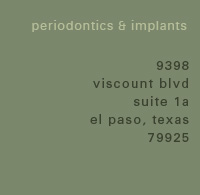- general information
- patient information
- Periodontal Overview
- ––––––––––––––––––––––––––––––––––
- Periodontal Disease and Heart Disease
- Diabetes and Periodontal Diseases
- Periodontal Disease Risk Factors
- Periodontal Complications
- Oral Cancer
- • Biopsy
- Maintaining Periodontal Health throughout a Woman's Lifetime
- Other Diseases and Their Relationship to Periodontal Disease
- Heart Disease: Precautions to be Taken Before Dental Treatment
- Poor Nutrition and Periodontal Disease
- ––––––––––––––––––––––––––––––––––
- What is "Good Oral Hygiene"?
- How to Brush
- How to Floss
- How to Care for Sensitive Teeth
- Hygiene Products
- • Toothbrush Care
- ––––––––––––––––––––––––––––––––––
- New Patient FAQs
- First Visits FAQs
- non-surgical periodontal care
- periodontal therapies
- Traditional Pocket Reduction Therapy
- • Bone Grafting
- ––––––––––––––––––––––––––––––––––
- PerioLase™ LANAP Therapy
- ––––––––––––––––––––––––––––––––––
- Cosmetic Surgery to Improve the Appearance of Your Smile
- • Crown Lengthening to Improve the Esthetics of Your Smile
- • Soft Tissue Grafting to Address Gingival Recession (Root Coverage Grafting)
- Platelet Rich Plasma (PRP)
- Crown Lengthening to Repair a Damaged Tooth
- Exposure / Bracketing of Impacted Tooth
- • Procedure Description for Exposure/Bracketing of Impacted Tooth
- ––––––––––––––––––––––––––––––––––
- Pocket Reduction Surgery FAQs
- Other Therapies FAQs
- dental implants
- Introduction to Dental Implants
- • Single Missing Tooth
- • Two or More Missing Teeth
- • Current Denture User
- • Benefits of Dental Implants
- ––––––––––––––––––––––––––––––––––
- CT Scanner & Comprehensive Implant Planning
- Conscious I.V. Sedation: Is It Right for You?
- ––––––––––––––––––––––––––––––––––
- Socket Preservation Techniques
- Ridge Augmentation and Bone Grafting
- Sinus Graft
- Platelet Rich Plasma
- Routine Implant Maintenance
- our doctors & staff
- office information






Home
Periodontal Therapies
- Traditional Pocket Reduction Therapy
- • Bone Grafting
- PerioLase™ LANAP Therapy
- Cosmetic Surgery to Improve the Appearance of Your Smile
- • Crown Lengthening to Improve the Esthetics of Your Smile
- • Soft Tissue Grafting to Address Gingival Recession (Root Coverage Grafting)
- Platelet Rich Plasma (PRP)
- Crown Lengthening to Repair a Damaged Tooth
- Exposure / Bracketing of Impacted Tooth
- • Procedure Description for Exposure/Bracketing of Impacted Tooth
- Pocket Reduction Surgery FAQs
- Other Therapies FAQs
Exposure / Bracketing of an Impacted Tooth
An impacted tooth simply means that the tooth is “stuck” in the bone of your jaw and cannot erupt into a functional position. Patients frequently develop similar problems with impacted third molar (wisdom) teeth. These teeth get “stuck” in the back of the jaw and can develop painful infections among a host of other problems. Since there is rarely a functional need for wisdom teeth, they are usually extracted if they develop problems. The maxillary cuspid (upper eye tooth) is the second most common tooth to become impacted and we will use this situation to explain the concept of surgical exposure of impacted teeth. The cuspid tooth is a critical tooth in the dental arch and plays an important role in your “bite”. The cuspids are very strong biting teeth that have the longest roots of all human teeth. They are designed to be the first teeth that touch when your jaws close together, so they can guide the rest of the teeth into the proper bite relationship. They also carry most of the load placed on the teeth as your upper and lower jaws move side to side. If you do not have these key support teeth, the adjacent teeth take this load and their roots and bony foundation are not well designed to take these forces and loads.

Normally, the maxillary cuspids are the last of the “front” teeth to erupt into place. They usually come into place around ages 11 to13 and cause any space left between the upper teeth to close tightly together. If a cuspid tooth becomes impacted, every effort is made to get it to erupt into its proper position in the dental arch. The techniques involved to aid eruption can be applied to any impacted tooth in the upper or lower jaw, but most commonly they are applied to the maxillary cuspid (upper cuspids). Sixty percent of these impacted eye-teeth are located on the palatal (roof of the mouth) side of the dental arch. The remaining impacted eye teeth are found in the middle of the supporting bone but they are stuck in an elevated position above the roots of the adjacent teeth or out to the facial side (outer aspect) of the dental arch.
EARLY RECOGNITION – THE KEY TO SUCCESSFUL TREATMENT
The older the patient, the more likely an impacted eye tooth will not erupt by nature’s forces alone, even if space is available for the tooth to fit in the dental arch. The American Association of Orthodontists recommends that a Panorex screening X-ray along with a dental examination be performed on all dental patients at around the age of 7 years to count the teeth and determine if there are problems with eruption of the adult teeth. It is important to determine whether all the adult teeth are present or to determine if some adult teeth are missing. Are there extra teeth present or are there any unusual growths that are blocking the eruption of the eye tooth? Is there extreme crowding or too little space available, causing an eruption problem with the eye tooth? This exam is usually performed by your general dentist or hygienist who will refer you to an orthodontist if a problem is identified. Treating such a problem may involve an orthodontist placing braces to open spaces to allow for proper eruption of the adult teeth. Treatment may also require a referral to a surgeon for extraction of retained baby teeth and/or selected adult teeth that are blocking the eruption of the all-important eye-teeth. The surgeon will also need to remove any extra teeth (supernumerary teeth) or growths that are blocking eruption of any of the adult teeth. If the eruption path is cleared and the space is opened up by age 11 or 12, there is a good chance the impacted eye tooth will erupt with nature’s help alone. If the eye tooth is allowed to develop too long (age 13 – 14), the impacted eye tooth will not erupt by itself even with the space cleared for its eruption. If the patient is too old (over 40), there is a much higher chance the tooth will be fused in position. In these cases the tooth will not budge despite all the efforts of the orthodontist and surgeon to erupt it into place. Sadly, the only option at this point is to extract the impacted tooth and consider an alternate treatment to replace it in the dental arch (crown on a dental implant or a fixed bridge).
9398 Viscount Blvd, Suite 1-A | El Paso, TX 79925 | Tel 915-598-6702 | Fax 915-593-7478
Home | General Information | Patient Information | Non-Surgical Periodontal Care | Periodontal Therapies | Dental Implants | Our Doctors & Staff
Contact Us | Referring Doctors | Disclaimer | Sitemap | Periodontic Website Designby PBHS 2012©